Consolidation
The Consolidation to Upper West Shore School District No. 33
Long time resident, trustee, and long time district clerk Jack Meuli reported that in 1964 the school boards of Dayton, Proctor and Rollins voted
to see if there was an interest in the community to consolidate, as all three schools were getting smaller (especially Rollins and Proctor). A vote of the people in each district was held. The people in Dayton voted to consolidate. Rollins voted against and Proctor voted almost 90 percent against.
In 1967 the boards of Dayton and Rollins voted to run the two schools together but not to consolidate. The lower grades (1-4) were in Rollins with two teachers and the upper grades in Dayton, also with two teachers. A bus ran between the two schools. Proctor still operated independently.
 The consolidation topic was again brought up in 1972. Following action by each board and school district elections in each community, Proctor District #23, Rollins District #41, and Dayton District #36 consolidated officially July 1, 1972 into Upper West Shore Elementary School District #33. Glennadene Ferrell's draft news release prior to the elections stated:
The consolidation topic was again brought up in 1972. Following action by each board and school district elections in each community, Proctor District #23, Rollins District #41, and Dayton District #36 consolidated officially July 1, 1972 into Upper West Shore Elementary School District #33. Glennadene Ferrell's draft news release prior to the elections stated:
Saturday, June 3, the electors of School Districts #24-Proctor, #36-Dayton, and #41-Rollins will go to the polls at their respective schoolhouses to cast their ballots for or against consolidation of the three districts. Glennadene Ferrell, Lake County Superintendent of Schools, states among the advantages of consolidation are simplified budgeting, and a reduction of property taxes for at least the three year State Consolidation payment period. But a greater advantage than either of these is assurance of a better education for the children of these districts for their first eight years of schooling, thereby enabling them to be better prepared when they leave the area for high school. Polls are open from noon to 8 PM.
The official election results show an extremely close election at both Rollins and Proctor with Dayton overwhelmingly carrying the election for consolidation. Votes were: Rollins 42 votes for and 38 against consolidation; Proctor with 30 votes for and 28 against consolidation; and Dayton with 27 votes for and none against consolidation. While the consolidation issue was long ago resolved, it is still an occasionally sensitive topic in the communities.
County Superintendent Ferrell appointed Mrs. Rose Schultz to be chairman of the trustees. Other trustees appointed by Mrs. Ferrell were: Gary Thomas and C. L. Fischer, Jr. All would serve until the school election of April, 1973. Mr. Thomas and Fischer and Daryl Proud became the 1973-74 trustees with Jack Meuli serving as district clerk throughout the consolidation. Funds were transferred from each district to the new district to total the following: General Fund- $24,430.50, Transportation - $6,336.78, Retirement - $927.72, and the Building Fund - $2,157. The School Lunch Fund was $1.17 in the red and the J.O.M. Reading Fund had a balance of $6.56. School was held in all three schools with one teacher teaching two or three grades in all three schools.




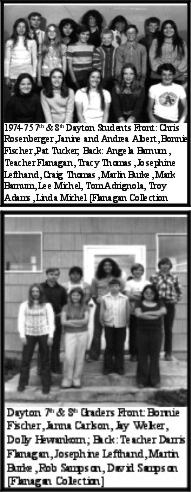
Darris Flanagan was hired to teach the seventh and eighth grades following Lois Meuli and he stayed on through the 1977-78 school year. His second year at Dayton was the last year of school at Proctor. He remembered no problems on the transfer of students amongst the three schools. "It seemed smooth" and he thought the only reason the board voted to close Proctor was because it was getting "run down" and they wanted to save money operating the facility. He said the teachers (he and Lois Meuli) were happy to be together to share teaching duties. He taught grades seven and eight and Lois taught grades four through six while Wanda White taught the lower grades alone at Rollins. That pattern continued for three years. Darris Flanagan "loved teaching at Dayton." He said the students worked hard and scored high on achievement tests. He had two students who never missed a problem on the math portion. They had great field trips to Meuli's to look for arrowheads, watched the filming of Winterhawk, and went to Glacier Park. The only reason he moved on was a more than 37% salary increase offer. Obviously his enthusiasm for teaching was appreciated as District Clerk Dee Adams said he was the "neatest, most enthusiastic teacher ever!" She drove a station wagon full of the giggling girls on the field trip to Columbia Falls water slides when they watched the filming of Winterhawk. Dee's son Troy absolutely adored Mr. Flanagan. Darris coached the students in track and Mariea Schultz (now Johnson) went on to hold the Polson High School record in the 800 and 1600 for nearly ten years. Mr. Flanagan now teaches at Kalispell.
 By 1979 enrollment had decreased to the point that Rollins too was closed with Dayton remaining open with two teachers. The district continues to operate as Upper West Shore Elementary School District #33 with school held at the Dayton school house. The other two school houses remain the property of the district and are well maintained by the communities to serve as community centers.
By 1979 enrollment had decreased to the point that Rollins too was closed with Dayton remaining open with two teachers. The district continues to operate as Upper West Shore Elementary School District #33 with school held at the Dayton school house. The other two school houses remain the property of the district and are well maintained by the communities to serve as community centers.
Linda Gore came to Dayton to teach in 1980 when Dayton was the only school in operation. Junior high and high school-age youngsters belong to the Polson High School district. Gore, who taught in a two-room rural school in eastern Montana right after graduating from college in Billings, said coming to Dayton in 1980 was like "coming home." The countryside is a bit different, the Sidney native said, but the extended family atmosphere was wonderful. Linda Gore's upper elementary students wrote histories of the Proctor, Dayton, and Rollins area in 1984 which later got published IN THE SHADOWS OF THE MISSIONS. While teaching Linda played the piano for every Christmas program and still plays for the yearly program. Gore taught in Dayton until her presence was required to take care of her seriously ill father and husband's mother, who moved from Colorado to be close to their son and family. Her parents have since passed away. In 1994, Gore was appointed to the school board. The following year, she was elected in her own right and still serves being again elected. Gore doesn't know if she'll run again. It's good and necessary work, she said. "But it isn't fun."
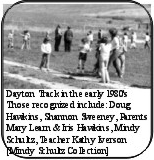
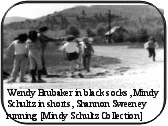
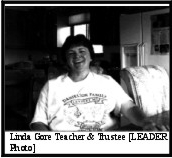
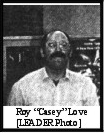 Casey Love was first hired to teach grades 4-6 at Dayton in 1992. This is his first teaching job; he received his bachelor's degree in December from Western Montana College. Love also has an associate degree in forestry from Flathead Valley Community College in Kalispell, and has worked for the U. S. Forest Service, and also as an electrician and carpenter. While earning his teaching degree, Love decided he would like to work at a rural school. "I like the opportunities that a small school provides," he says. Casey now teaches all grades at Dayton with the assistance of two aides. He has set up the technology system and has students actively using computers throughout the curriculum. The students researched their community and created the Dayton Map available at the school and local sites.
Casey Love was first hired to teach grades 4-6 at Dayton in 1992. This is his first teaching job; he received his bachelor's degree in December from Western Montana College. Love also has an associate degree in forestry from Flathead Valley Community College in Kalispell, and has worked for the U. S. Forest Service, and also as an electrician and carpenter. While earning his teaching degree, Love decided he would like to work at a rural school. "I like the opportunities that a small school provides," he says. Casey now teaches all grades at Dayton with the assistance of two aides. He has set up the technology system and has students actively using computers throughout the curriculum. The students researched their community and created the Dayton Map available at the school and local sites.
The new teacher at Dayton in 1995 for the primary grades kindergarten through third grade was Charles Apperson who stayed for two years before moving on:
A native of Biddle, Apperson previously taught K-3 at Biddle Elementary for two years before moving on to Joe (formerly Ismay), where he taught grades 4-8 at Whitney Creek and 1-8 at Trail Creek for one year each. He earned his elementary education degree at Montana State University and also has an associated arts degree, with an emphasis on land surveying, from Dawson Community College in Glendive. His hobbies include boating, tennis, and downhill skiing.
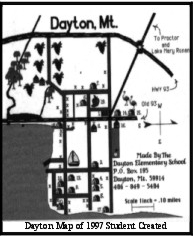 Since then declining enrollment has raised questions about the future of what is believed to be Montana's oldest continuously operating school. Trustees voted to retain only one teacher, Casey Love, for the two-room school for the 1997-98 school year. When Linda Gore began teaching in Dayton, the school had 30 pupils. By 1997 past year when she was a trustee, enrollment dropped to a dozen. Much of the year was spent with staff and trustees working to incorporate federal Chapter 1 entitlements into the whole school's curriculum. Federal funds pay for one aide and part of another one's salary. The lone teacher, Casey Love, has the assistance of two aides, both of whom he's worked with for several years. The student-teacher ratio should make up for lack of facilities found in larger schools, Gore believes. Another plus for the rural schools is their high ratio of computers to students with a well-trained teacher capable integrating modern technology and traditional instructional strategies. The school has successfully modernized.
Since then declining enrollment has raised questions about the future of what is believed to be Montana's oldest continuously operating school. Trustees voted to retain only one teacher, Casey Love, for the two-room school for the 1997-98 school year. When Linda Gore began teaching in Dayton, the school had 30 pupils. By 1997 past year when she was a trustee, enrollment dropped to a dozen. Much of the year was spent with staff and trustees working to incorporate federal Chapter 1 entitlements into the whole school's curriculum. Federal funds pay for one aide and part of another one's salary. The lone teacher, Casey Love, has the assistance of two aides, both of whom he's worked with for several years. The student-teacher ratio should make up for lack of facilities found in larger schools, Gore believes. Another plus for the rural schools is their high ratio of computers to students with a well-trained teacher capable integrating modern technology and traditional instructional strategies. The school has successfully modernized.
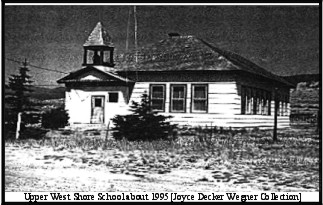 But times are changing and rural schools are fading from the Montana landscape. While Gore isn't planning on being the part of the demise of Dayton School, she recognizes that it could happen. The small schools have consolidated because of economic necessity, she noted. The board's research concluded that becoming part of the Polson school district would quadruple the local property tax mill levy from 11 mills to about 44 mils, Gore said. The school board voted to run a mill levy to establish a building reserve fund of $20,000 over two years to maintain and repair the aging facility. Teacher Casey Love had spent considerable time that winter in the mud under the school fixing leaking plumbing. People attending the public meeting prior to the vote were mixed in their support for keeping the rural school but they are well aware of their tax advantage. The levy passed and the repairs were made.
But times are changing and rural schools are fading from the Montana landscape. While Gore isn't planning on being the part of the demise of Dayton School, she recognizes that it could happen. The small schools have consolidated because of economic necessity, she noted. The board's research concluded that becoming part of the Polson school district would quadruple the local property tax mill levy from 11 mills to about 44 mils, Gore said. The school board voted to run a mill levy to establish a building reserve fund of $20,000 over two years to maintain and repair the aging facility. Teacher Casey Love had spent considerable time that winter in the mud under the school fixing leaking plumbing. People attending the public meeting prior to the vote were mixed in their support for keeping the rural school but they are well aware of their tax advantage. The levy passed and the repairs were made.
Dayton and Valley View Elementary School staff, board representatives, and the county superintendent meet regularly with Polson School District #23 administrators and board to work out common transitional issues. So the outlying school district students, such as those from the West Shore, have priority if they wish to transfer to Polson elementary schools, but there isn't any assurance they will be accepted because growing school enrollment is becoming a critical issue in Polson. Gore said at least one youngster was denied entrance last year.. Still, the rural elementary population is dwindling. Ranchers and logging families in the area are ceasing to exist as the new generations leave for greener economic pastures. Others are finding it too difficult and expensive to commute to Kalispell or Polson to work, she said. One parent told her that it was easier to take her child to the town where she was employed than to leave the youngster at Dayton. Besides, there were more activities at the larger school even though the rural schools have more computer access and are on the Internet. Band and sports programs are hard to compete with. The district's bus driver retired at the end of the 1995-96 school year. The district couldn't find anyone wanting to bid on the route. As a result, parents are now responsible for getting the kids to school. Many aren't happy about that, even though they receive a transportation stipend to do so it's easier to bus the kids to Polson, Gore said. Closing Dayton School would be unfortunate, Gore believes. The rural school setting is really a marvelous educational setting, she said.
